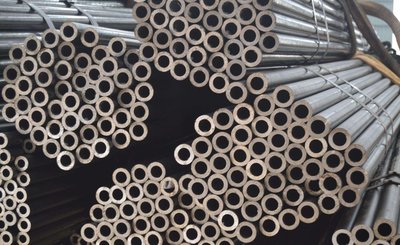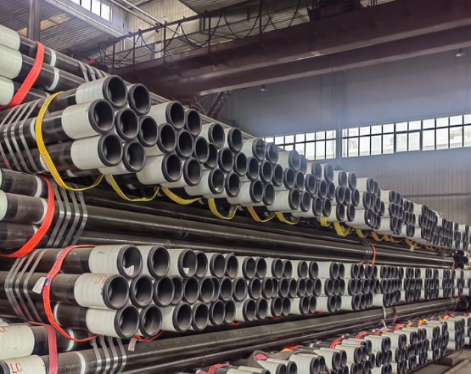In the manufacture of seamless pipe, there are many reasons to make the steel pipe magnetic, and the main reasons for the residual magnetism of the steel pipe are process magnetism and induced magnetism.
1. Induced magnetism often occurs in the pipe making process of the factory. Among them, the magnetization non-destructive inspection mainly refers to eddy current flaw detection. The eddy current flaw detection equipment is simple to operate and easy to master. If used properly, it can detect most defects in steel pipes.
2. Process magnetism often occurs during assembly and welding operations and when magnetic clamps are used to weld pipes with DC current, such as: long-term contact with wires connected to DC power supply, exposed wire sections or short circuits between welding clamps and pipes, etc.
Harm of residual magnetism in seamless steel pipe
When using magnetic seamless steel pipes, it is often seen that the arc combustion is unstable, and it is difficult to ignite the arc, the deviation of the arc in the magnetic field, and the liquid metal and slag melt splashing out of the weld pool. In order to stabilize the welding process and improve the quality of welded joints, the magnetized steel pipe must be demagnetized before welding. It is difficult to achieve complete demagnetization of the welded steel pipe, so when the residual magnetism is not enough to affect the welding quality, welding is allowed

The seamless steel pipe degaussing method is the most commonly used method:
1. The coil is wound on the outside of the steel pipe, so that the coil passes through the alternating current, and the current of the alternating current is slowly reduced until it drops to zero. Degaussing result: the physical properties of the seamless steel pipe are not changed, but the seamless steel pipe is also magnetized when it encounters an external magnetic field again.
2. Through the heat treatment process, it can be more thoroughly degaussed. However, after degaussing, the hardness and rigidity of the seamless pipe will change. In the future, if it encounters an external magnetic field, and the magnetic field is removed, the steel pipe will basically have no residual magnetism.
3. Heat treatment process. After heating to a certain temperature without oxygen, it takes 72 hours to slowly cool to room temperature
Conclusion
If the seamless pipe cannot effectively eliminate the residual magnetism, it will inevitably have an adverse effect on the use. It is an indispensable step to ensure the quality of the product and maintain the image of the product. When the seamless steel pipe is found to contain residual magnetism that affects welding during on-site installation, a simple, efficient and time-saving method must be selected to solve the impact of residual magnetism
1. Induced magnetism often occurs in the pipe making process of the factory. Among them, the magnetization non-destructive inspection mainly refers to eddy current flaw detection. The eddy current flaw detection equipment is simple to operate and easy to master. If used properly, it can detect most defects in steel pipes.
2. Process magnetism often occurs during assembly and welding operations and when magnetic clamps are used to weld pipes with DC current, such as: long-term contact with wires connected to DC power supply, exposed wire sections or short circuits between welding clamps and pipes, etc.
Harm of residual magnetism in seamless steel pipe
When using magnetic seamless steel pipes, it is often seen that the arc combustion is unstable, and it is difficult to ignite the arc, the deviation of the arc in the magnetic field, and the liquid metal and slag melt splashing out of the weld pool. In order to stabilize the welding process and improve the quality of welded joints, the magnetized steel pipe must be demagnetized before welding. It is difficult to achieve complete demagnetization of the welded steel pipe, so when the residual magnetism is not enough to affect the welding quality, welding is allowed

The seamless steel pipe degaussing method is the most commonly used method:
1. The coil is wound on the outside of the steel pipe, so that the coil passes through the alternating current, and the current of the alternating current is slowly reduced until it drops to zero. Degaussing result: the physical properties of the seamless steel pipe are not changed, but the seamless steel pipe is also magnetized when it encounters an external magnetic field again.
2. Through the heat treatment process, it can be more thoroughly degaussed. However, after degaussing, the hardness and rigidity of the seamless pipe will change. In the future, if it encounters an external magnetic field, and the magnetic field is removed, the steel pipe will basically have no residual magnetism.
3. Heat treatment process. After heating to a certain temperature without oxygen, it takes 72 hours to slowly cool to room temperature
Conclusion
If the seamless pipe cannot effectively eliminate the residual magnetism, it will inevitably have an adverse effect on the use. It is an indispensable step to ensure the quality of the product and maintain the image of the product. When the seamless steel pipe is found to contain residual magnetism that affects welding during on-site installation, a simple, efficient and time-saving method must be selected to solve the impact of residual magnetism









